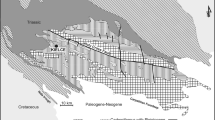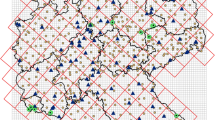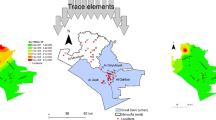Abstract
The International Atomic Energy Agency (IAEA) organized a co-ordinated research project (CRP) on “Validation and application of plants as biomonitors of trace element atmospheric pollution analysed by nuclear and related techniques” involving 14 participating countries. The CRP’s objective was to identify appropriate bioindicators for local and/or regional application and validate them for general air pollution monitoring. Activities included quantification studies, research into spatial and time resolution for particular organisms, and physiological studies. A number of suitable bioindicators were identified in different parts of the globe and tested during the CRP. Sampling strategies were reviewed and the recommended approach adopted by the group. Appropriate sample preparation procedures were assessed and harmonised to the degree allowed by different geographic and climatic conditions in the participating countries. Two interlaboratory comparison exercises were carried out on lichen and moss materials. Results confirmed definite improvement in analytical performance of the participating laboratories, but also revealed possible inconsistencies due to different sample processing procedures. Several monitoring surveys were carried out and consequently pollution maps drawn for extended areas or countries. Overall results confirmed applicability of lower plants for assessing the degree of atmospheric pollution and provided several countries with effective monitoring tools not used before.
Similar content being viewed by others
References
Berg, T., Roeyset, O., and Steinnes, E., 1995: Moss (Hylocomium splendens) used as biomonitor of atmospheric trace element deposition: Estimation of uptake efficiencies, Atmos. Environ. 29, 353–360.
Berg, T. and Steinnes, E., 1997: Use of mosses (Hylocomium splendens and Pleurozium schreberi) as biomonitors of heavy metal deposition: From relative to absolute deposition values, Environ. Pollut. 98, 61–71.
Bleise, A. and Smodiš, B., 1999: Report on the Intercomparison Run NAT – 5 for the Determination of Trace and Minor Elements in Two Lichen Samples, Report NAHRES – 46, International Atomic Energy Agency, Vienna, Austria.
Bleise, A. and Smodiš, B., 2001: Report on the Quality Control Study NAT – 6 for the Determination of Trace and Minor Elements in Two Moss Samples, Report NAHRES – 66, International Atomic Energy Agency, Vienna, Austria.
Garty, J., 1993: Lichens as biomonitors for heavy metal pollution, in B. Markert (ed.), Plants as Biomonitors: Indicators for Heavy Metals in the Terrestrial Environment, VCH, Weinheim, pp. 193–263.
Gjengedal, E and Steinnes, E., 1990: Uptake of metal ions in moss from artificial precipitation, Environ. Monit. Assess. 14, 77–87.
IAEA, 1999: Co-ordinated Research Project on Validation and Application of Plants as Biomonitors of Trace Element Atmospheric Pollution, Analysed by Nuclear and Related Techniques, Report on the First Research Co-ordination Meeting, Report NAHRES – 45, International Atomic Energy Agency, Vienna, Austria.
IAEA, 2001: Co-ordinated Research Project on Validation and Application of Plants as Biomonitors of Trace Element Atmospheric Pollution, Analysed by Nuclear and Related Techniques, Report on the Second Research Co-ordination Meeting, Report NAHRES – 63, International Atomic Energy Agency, Vienna, Austria.
Markert, B. A., Breure, A. M., and Zechmeister H. G., 2003: Definitions, strategies and principles for bioindication/biomonitoring of the environment, in B. A. Markert, A. M. Breure, and H. G. Zechmeister (eds.), Bioindicators & Biomonitors: Principles, Concepts and Applications, Elsevier, Amsterdam, pp. 3–39.
Rühling, Å. and Tyler, G., 1968: An ecological approach to the lead problem, Bot. Not. 122, 248–342.
Smodiš, B. and Parr, R. M., 1999: Biomonitoring of air pollution as exemplified by recent IAEA programs, Biol. Trace Elem. Res. 71–72, 257–266.
Steinnes, E., 1993: Some aspects of biomonitoring of air pollutants using mosses, as illustrated by the 1976 Norwegian study, in B. Markert, (ed.), Plants as Biomonitors: Indicators for Heavy Metals in the Terrestrial Environment, VCH, Weinheim, pp. 381–394.
UNECE, 2003: Heavy Metals in European Mosses: 2000/2001 Survey, United Nations Economic Commission for Europe International Cooperative Programme on Effects of Air Pollution on Natural Vegetation and Crops, Centre for Ecology and Hydrology, University of Wales Bangor, UK.
Wolterbeek, H. T., Garty, J., Reis, M. A., and Freitas, M. C., 2003: Biomonitors in use: Lichens and metal air pollution, in B. A. Markert, A. M. Breure, and H. G. Zechmeister (eds.), Bioindicators & Biomonitors: Principles, Concepts and Applications, Elsevier, Amsterdam, pp. 3–39.
Zechmeister, H. G., Grodzińska, K., and Szarek-Łukaszewska, G., 2003: Bryophytes, in B. A. Markert, A. M. Breure, and H. G. Zechmeister (eds.), Bioindicators & Biomonitors: Principles, Concepts and Applications, Elsevier, Amsterdam, pp. 329–375.
Author information
Authors and Affiliations
Corresponding author
Rights and permissions
About this article
Cite this article
Smodiš, B., Pignata, M.L., Saiki, M. et al. Validation and Application of Plants as Biomonitors of Trace Element Atmospheric Pollution – A Co-Ordinated Effort in 14 Countries. J Atmos Chem 49, 3–13 (2004). https://doi.org/10.1007/s10874-004-1210-2
Received:
Accepted:
Issue Date:
DOI: https://doi.org/10.1007/s10874-004-1210-2




